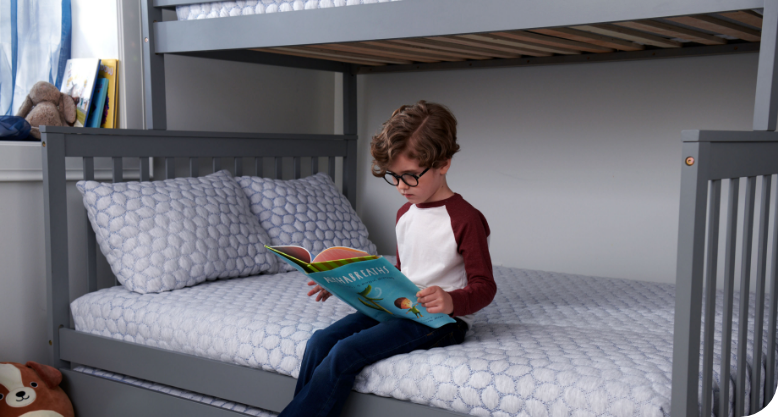5 Steps for a Smoother Toddler Bedtime Routine
I wish I could have half of the energy toddlers have! They are on the go from the second they get up to when they very reluctantly fall asleep at night.
Bedtime struggles with toddlers can take many forms. Perhaps your little one doesn't want to stop playing with their toys, or they insist on one more story before sleep. You, on the other hand, are hoping for a smooth transition where they happily get into bed and fall asleep.
A toddler bedtime routine can feel like a battle of wills, but with the right approach, you can create a smoother, more enjoyable end to the day for everyone. Here are my tips.
Why Are Bedtime Routines for Toddlers Important?


Bedtime routines are essential to smoother bedtimes because they signal to a child’s body and mind that it's time to wind down and prepare for sleep. Consistent childhood bedtime routines have been shown to:
- Improve sleep quality
- Reduce the time it takes to fall asleep
- Enhance cognitive development
A predictable routine at night can also help alleviate bedtime resistance and night wakings, which are common in young children. Best of all? It sets them up with healthy bedtime habits for life (something we all could benefit from!).
Better Bedtime Tips from a Gentle Sleep Coach
Though I can't guarantee a perfect bedtime, these are my favorite tips as a gentle sleep coach that will help to make your toddler's bedtime a little easier.
1. Put the Day to Bed Before You Get into Bed
Does your toddler or preschooler want to talk about their day as soon as they get into bed and should be falling asleep? If so, putting the day to bed before they get into bed might help you.
I like to do this during dinnertime. Start with the morning, and ask your child questions about what they had for breakfast, why they chose to wear what they wore, etc., and go through their entire day. Ask questions about their activities and who they talked to and played with.
If your child suddenly remembers something from earlier in the day when they get into bed, they’ll want to talk to you about it. By helping them process their day before they start slowing their mind down and falling asleep, you’re setting them up for a better bedtime.
2. Incorporate Relaxing (But Fun!) Activities


Your toddler bedtime routine should be approximately 30-45 minutes. No shorter, no longer – this is all the time you should need to help your child get unwound and relaxed.
You want this routine to be as effective as possible. But effective doesn't have to mean boring! We want your child to enjoy getting ready for bed as much as you enjoy it. Your routine can involve some calm playtime – it’s best to avoid their favorite toys, as that could excite them too much, but reading books, doing puzzles, etc., are perfect activities for your relaxing bedtime routine.
3. Dim the Room
Honing your child's sleep environment (including their mattress!) is essential. Lighting in particular plays a crucial role in preparing our bodies for sleep. Dimming the lights an hour or so before bedtime helps stimulate the production of melatonin, the sleep hormone.
In your child's bedroom, use a nightlight or lamps with soft, warm lighting to create an environment conducive to sleep. Bright white or blue light is like daylight and will confuse the brain – the body won’t know that it's sleepy time.
The same goes for screens. Looking at a screen will not only inhibit melatonin production, but it’s also very mentally stimulating, which can make it harder to fall asleep. Keep screens out of the bedroom (your child’s room and your own!).
4. Remember: Consistency Is Key
The most effective toddler bedtime routines are those that are consistent. When your bedtime routine is consistent, it's predictable, and when we know what's going to happen next, we are more relaxed. The more relaxed your child is, the easier it is for them to fall asleep.
But you don't want this routine to be too consistent! If there are no variations in your routine, your children will become bored and begin to find ways to entertain themselves, meaning that they may get up to mischief. It’s all about balance.
Try to perform different variations of the same activities in the same order every night to help reinforce the body's sleep-wake cycle and make it easier for your child to settle down. Have some quiet playtime, but pick different toys every night. One night, you can play with the cars; the next, do some coloring. You can read different books and sing different songs. The play part of the routine is always there, but you're mixing things up.
5. Keep It Slow and Steady
Have you ever tried to rush through your toddler bedtime routine because you had a babysitter coming and wanted to head out? How did that go?
Bedtime probably took much longer than usual! Your child knows when they're being rushed, and when we're rushed, we're not relaxed. Go through your routine slowly and steadily for an easier bedtime.


The bottom line? Toddlers and preschoolers are expert procrastinators and are likely to delay their bedtime. There’s no changing that. Still, by following these tips, you should be able to help make your toddler bedtime routine smoother and less exhausting for the family.
Struggling with your infant’s bedtime, too? Check out with my tips for creating a sleep inducing nursery for babies.

 Baby
Baby

 Kids
Kids

 Learn
Learn

 FIND A STORE
FIND A STORE CONTACT
CONTACT



